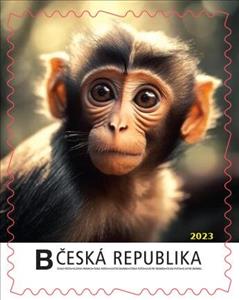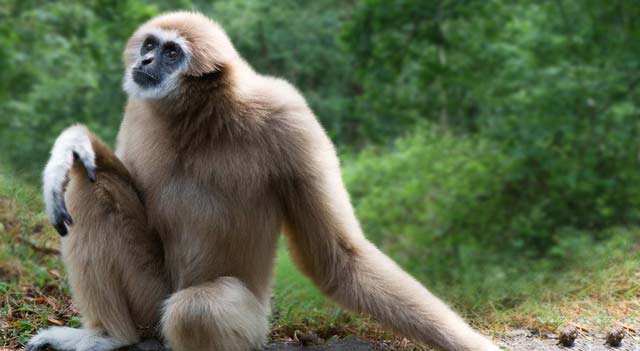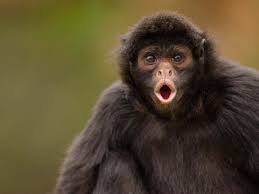Stamp: Obrázek umělé inteligence: Opice (Personalized and Private Mail Stamps 2023)
Obrázek umělé inteligence: Opice (Personalized and Private Mail Stamps 2023)
05 June (Personalized and Private Mail Stamps ) within release Czech Republic : My Own Stamps goes into circulation Stamp Obrázek umělé inteligence: Opice face value B No Face Value
| Stamp Obrázek umělé inteligence: Opice in catalogues | |
|---|---|
| POFIS: | POF: CZ VZ1640 |
Stamp is square format.
Also in the issue Czech Republic : My Own Stamps:
- Stamp - Obrázek umělé inteligence: Brouk face value B;
- Stamp - Obrázek umělé inteligence: Čivava face value B;
- Stamp - Obrázek umělé inteligence: Delfín face value B;
- Stamp - Obrázek umělé inteligence: Ještěrka face value B;
- Stamp - Obrázek umělé inteligence: Kočka face value B;
- Stamp - Obrázek umělé inteligence: Kohout face value B;
- Stamp - Obrázek umělé inteligence: Koza face value B;
- Stamp - Obrázek umělé inteligence: Lední medvěd face value B;
- Stamp - Obrázek umělé inteligence: Lemur face value B;
- Stamp - Obrázek umělé inteligence: Myš face value B;
- Stamp - Obrázek umělé inteligence: Opice face value B;
- Stamp - Obrázek umělé inteligence: Orel face value B;
- Stamp - Obrázek umělé inteligence: Ovce face value B;
- Stamp - Obrázek umělé inteligence: Papoušek face value B;
- Stamp - Obrázek umělé inteligence: Ryba face value B;
- Stamp - Obrázek umělé inteligence: Slon face value B;
- Stamp - Obrázek umělé inteligence: Slunéčko sedmitečné face value B;
- Stamp - Obrázek umělé inteligence: Sova face value B;
- Stamp - Obrázek umělé inteligence: Surikata face value B;
- Stamp - Obrázek umělé inteligence: Tučňák face value B;
- Stamp - Obrázek umělé inteligence: Tygr face value B;
- Stamp - Obrázek umělé inteligence: Veverka face value B;
- Stamp - Obrázek umělé inteligence: wombat face value B;
- Stamp - Obrázek umělé inteligence: Želva face value B;
- Stamp - Obrázek umělé inteligence: Žirafa face value B;
- Full Pane - ZvÍŘata, KterÁ NeexistujÍ... face value 25*B;
Stamp Obrázek umělé inteligence: Opice it reflects the thematic directions:
Animals are multicellular, eukaryotic organisms of the kingdom Animalia (also called Metazoa). All animals are motile, meaning they can move spontaneously and independently, at some point in their lives. Their body plan eventually becomes fixed as they develop, although some undergo a process of metamorphosis later on in their lives. All animals are heterotrophs: they must ingest other organisms or their products for sustenance.
Apes (collectively Hominoidea /hɒmɪˈnɔɪdi.ə/) are a clade of Old World simians native to sub-Saharan Africa and Southeast Asia (though they were more widespread in Africa, most of Asia, and Europe in prehistory), which together with its sister group Cercopithecidae form the catarrhine clade, cladistically making them monkeys. Apes do not have tails due to a mutation of the TBXT gene. In traditional and non-scientific use, the term ape can include tailless primates taxonomically considered Cercopithecidae (such as the Barbary ape and black ape), and is thus not equivalent to the scientific taxon Hominoidea. There are two extant branches of the superfamily Hominoidea: the gibbons, or lesser apes; and the hominids, or great apes.
Mammals are any vertebrates within the class Mammalia (/məˈmeɪli.ə/ from Latin mamma "breast"), a clade of endothermic amniotes distinguished from reptiles (including birds) by the possession of a neocortex (a region of the brain), hair, three middle ear bones and mammary glands. All female mammals nurse their young with milk, secreted from the mammary glands. Mammals include the largest animals on the planet, the great whales. The basic body type is a terrestrial quadruped, but some mammals are adapted for life at sea, in the air, in trees, underground or on two legs. The largest group of mammals, the placentals, have a placenta, which enables the feeding of the fetus during gestation. Mammals range in size from the 30–40 mm (1.2–1.6 in) bumblebee bat to the 30-meter (98 ft) blue whale. With the exception of the five species of monotreme (egg-laying mammals), all modern mammals give birth to live young. Most mammals, including the six most species-rich orders, belong to the placental group. The largest orders are the rodents, bats and Soricomorpha (shrews and allies). The next three biggest orders, depending on the biological classification scheme used, are the Primates (apes and monkeys), the Cetartiodactyla (whales and even-toed ungulates), and the Carnivora (cats, dogs, seals, and allies).
Monkey is a common name that may refer to most mammals of the infraorder Simiiformes, also known as simians. Traditionally, all animals in the group now known as simians are counted as monkeys except the apes. Thus monkeys, in that sense, constitute an incomplete paraphyletic grouping; however, in the broader sense based on cladistics, apes (Hominoidea) are also included, making the terms monkeys and simians synonyms in regard to their scope.





